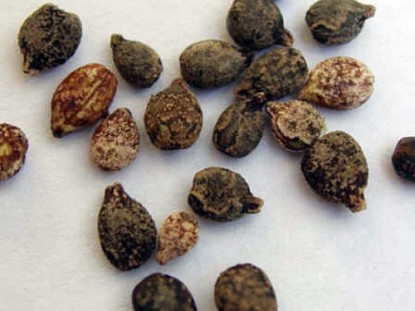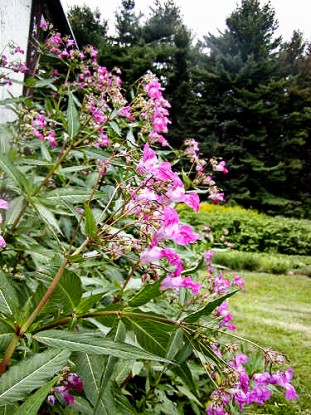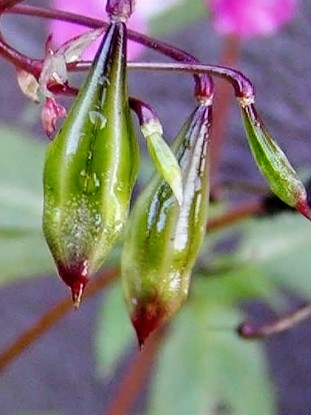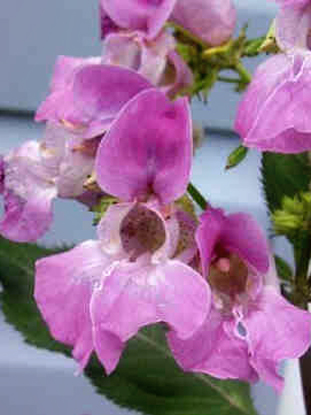
When someone told me that impatiens glandulifera seeds taste just like walnuts, I said, “Really, really? Hmmmm….I will have to see that for myself!” and so I have!
They do taste like walnuts–they do, they do! I am so excited about this discovery! I can grow my own nuts. Well, sort of.
I put some in my pumpkin muffins and they were delicious!
This opens a new door for people with nut allergies. You can now have so called “banana nut” muffins! Not only that, they are virtually free and you can grow them in your own yard.

Mine get about 4-6′ tall and have been known to reach 8′! They like moist shade. It’s an impatiens, but not the little ones that you buy cheap in every garden center in the spring. This is closer to the jewelweed, Impatiens capensis, with the same “touch-me-not” seed pods. If you grow them, you will learn to close your entire hand over the ripe seed pod before touching it. Spread them out to dry well before saving them for baking.

To plant the seeds, just sprinkle on the ground in the fall. They need a cold, moist winter and sunlight to germinate. They are prolific re-seeders! If you buy them now, just sprinkle on the ground, on top of the snow, where you want them to grow. When the snow melts they will come in contact with the soil and grow.
Warning: these can be very invasive! Mine are controlled by collecting most of the seeds.
They are also beautiful flowers for the back of the shade garden. The big, fuzzy yellow bumblebees love them – and so do I!

Sheryl blogs at Providence Acres.
Do you have a recipe post or kitchen-related story to share on the Farm Bell blog?
Read information here for Farm Bell blog submissions.Want to subscribe to the Farm Bell blog? Go here.



bonita says:
did you ever wonder who was the first to try something like impatiens glandulifera seeds so that we would know they were edible?
On January 30, 2011 at 1:34 am
bonita says:
…or that we can not eat the chestnuts from a horse chestnut tree?
On January 30, 2011 at 1:36 am
Astrid says:
Interesting post…Now I have to see/taste for myself also.
Do you think the seeds can go in the dehydrator to speed up the process?
On January 30, 2011 at 1:46 am
knancy says:
Ha! The ones who lived to tell the tale! But seriously, I thought you could eat cooked horse chestnuts – just not the outer covering/hull.
On January 30, 2011 at 4:55 am
CindyP says:
Very interesting, Sheryl! Thank you!
I see you have them for sale on your site! http://www.providenceacresfarm.com/farmstore_Can_US_seeds.htm
On January 30, 2011 at 7:41 am
Sheryl - Runningtrails says:
I do have them for sale 🙂
I don’t think a dehydrator would help. If you are buying the seeds they will already be dry. The ones I sell have been dried. What they need is wet cold.
I researched the time period needed: 6-8 weeks is enough cold. Plant outside 6-8 weeks before the last frost date for your area. I just scatter them on the ground, uncovered.
You can also plant them in trays and put those trays in your fridge, cold cellar, freezer or outside in the cold winter. Try them “winter sowed”.
On January 30, 2011 at 8:15 am
CindyP says:
I think Astrid was thinking of the drying process for eating……after they’ve grown and you’ve collected the seeds?
On January 30, 2011 at 9:11 am
Sheryl - Runningtrails says:
Ah! I don’t know. I assume they would be fine for eating if dried in a dehydrator. I don’t know if they would still germinate. Interesting. Try it and let us know 🙂
On January 30, 2011 at 11:24 am
Astrid says:
Yes Cindy was right, I thought of drying them in the dehydrator, to eat/use them quicker.
Of course the seeds you want to re seed, you dry them naturally.
On January 30, 2011 at 12:42 pm
Linda says:
This is too cool…..I love walnuts….I put them in everything…ok, just about everything. I want some seed to grow my own!
Linda
On January 30, 2011 at 2:00 pm
Frankie says:
Please be very careful with these – they are very, very invasive. They are on the noxious weed list here in WA. Here is more info on them.
Policeman’s Helmet
Impatiens glandulifera
History and Impact
Policeman’s helmet, also known as Himalayan balsam, thrives in moist areas and riparian zones. Although sometimes sold as an ornamental, this native of Asia has been added to the Washington State Noxious Weed list due to its invasive nature. In Britain, where the climate is similar to the Pacific Northwest, this plant is considered extremely invasive and is one of the “top 20” non-native weeds. As a Class B noxious weed, policeman’s helmet control is required in King County.
Biology and Morphology
Policeman’s helmet is an annual that germinates from February through March and flowers from June to October.Growing up to 10 feet tall, the upright stems are hollow with a purple or reddish tinge; leaves are oblong to egg-shaped, with serrated edges, with white, pink or purple flowers resembling an old-fashioned English policeman’s helmet. A single plant can produce up to 800 seeds, which are viable for 18 months or more and can even germinate under water. Since the plant often grows along streams and ditches, seeds spread quickly downstream. When touched, the mature seedpods split and eject seeds up to 20 feet. This trait has earned the Impatiens family the name of “touch me not.”
On January 30, 2011 at 3:32 pm
Sheryl - Runningtrails says:
I had heard that they were invasive. Mine don’t spread because I harvest most of the seed and also because there is no where nearby for them to grow. Nothing germinates in the grassy fields around my place but grass 🙁
I have ever only seen them growing wile in one location.
On January 30, 2011 at 8:01 pm